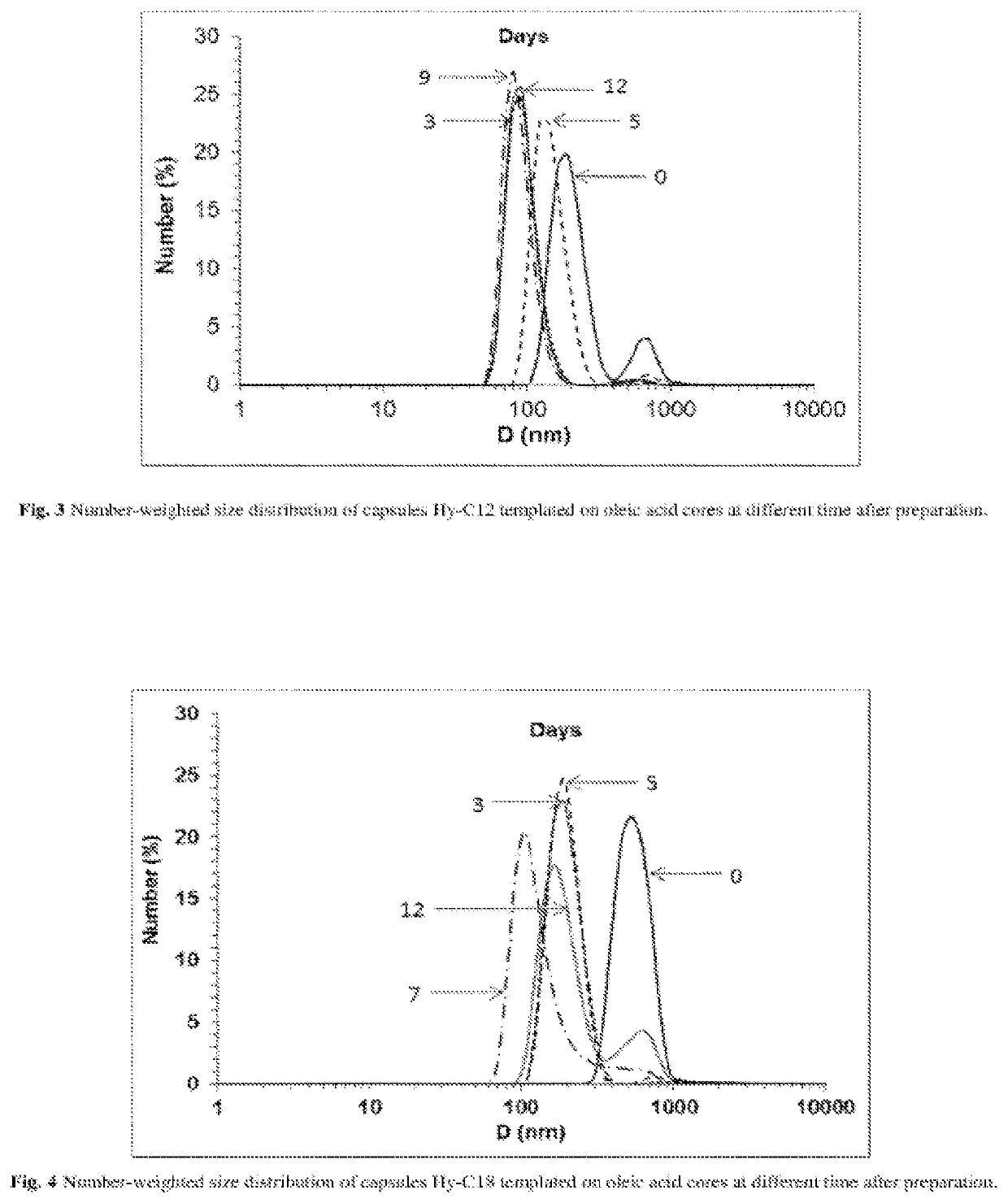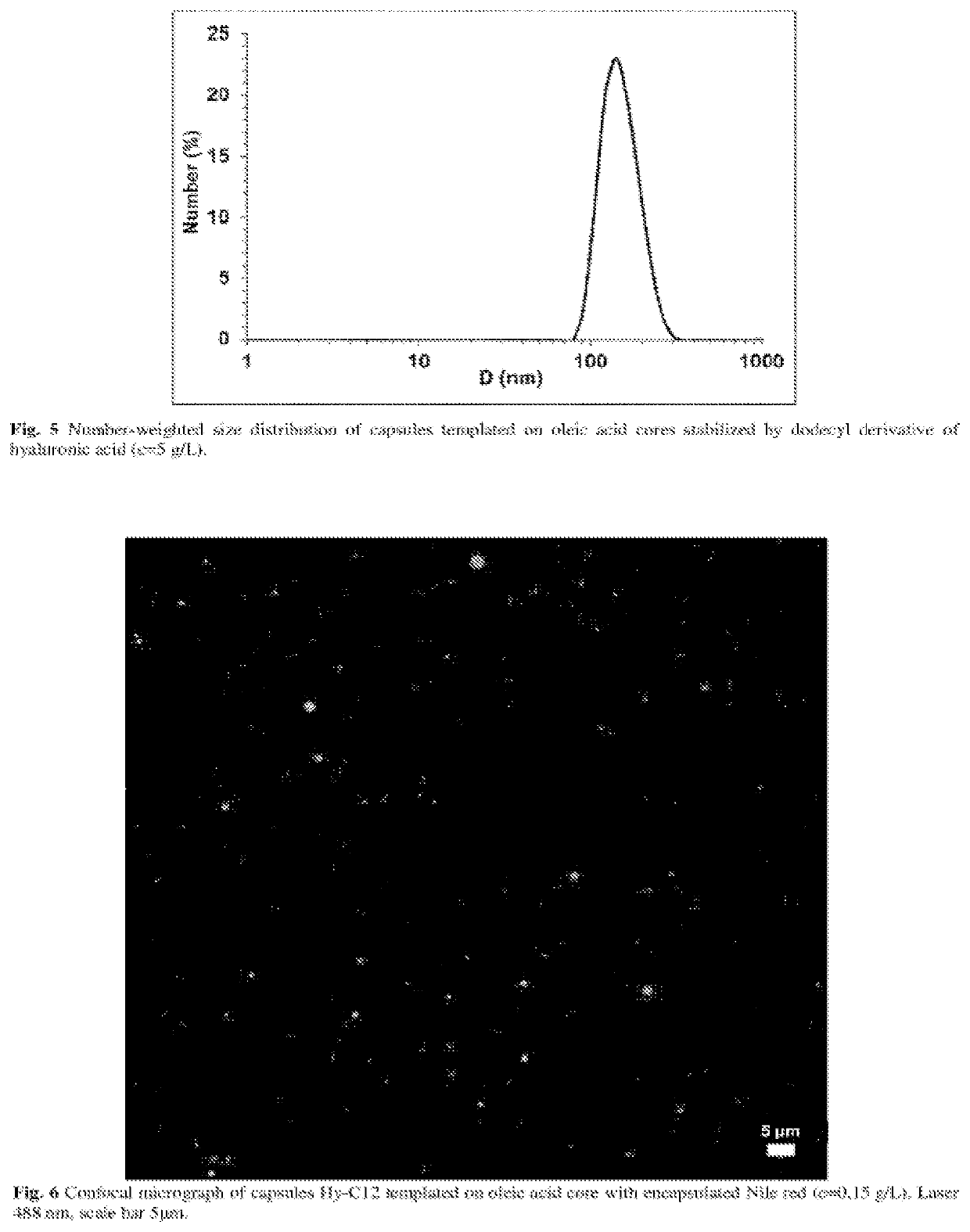Nanocapsule for delivery of lipophilic compound and process of preparation thereof
a lipophilic compound and nanocapsule technology, applied in the field of biocompatible polysaccharide-based capsules, can solve the problems of large challenge in obtaining stable droplets, serious limitation of the dynamic nature of interactions within the mousellar system, and the stability of aggregates being unstable, etc., to achieve high efficiency of encapsulation, low energy and financial inputs, and simple preparation
- Summary
- Abstract
- Description
- Claims
- Application Information
AI Technical Summary
Benefits of technology
Problems solved by technology
Method used
Image
Examples
example i
Preparation of Nanocapsules Templated on Oleic Acid Cores Stabilized by Hyaluronic Acid Modified with Hexylamine
[0061]Hyaluronic acid modified with hexyl side chains (Hy-C6) was dissolved in 0.1 M NaCl (1 g / L) and mixed with oleic acid (100:1 v / v). Both phases were vortexed for 5 minutes and emulsified for 30 minutes at room temperature in ultrasonic bath (540 W, 1-second pulse, 2-second break). Size of the resulted capsules was determined using dynamic light scattering technique (DLS) to be ca. 500 nm. The obtained capsules showed at least 2-week stability as confirmed by hydrodynamic diameter as well as zeta potential measurements. Two days after preparation a decrease in particle size was observed (to ca. 360 nm) what suggests destabilization of the aggregates and / or bigger capsules and formation of an emulsion containing only smaller and more stable particles (FIG. 1, Table 2).
example ii preparation
of Nanocapsules Templated on Oleic Acid Cores Stabilized by Hyaluronic Acid Modified with Octylamine
[0062]Mixture of an aqueous solution of hyaluronic acid modified with octyl side chains (Hy-C8) and oleic acid was prepared according to the procedure described in Example I. Size of the resulted capsules was determined using dynamic light scattering technique (DLS) to be ca. 700 nm. The obtained capsules showed at least 2-week stability as confirmed by hydrodynamic diameter as well as zeta potential measurements. Two days after sonication significant decrease in particle size was observed (to ca. 300 nm) what suggests destabilization of the aggregates and / or bigger capsules and formation of an emulsion containing only smaller and more stable ones. (FIG. 2, Table 2).
example iii preparation
of Nanocapsules Templated on Oleic Acid Cores Stabilized by Hyaluronic Acid Modified with Dodecylamine
[0063]Hyaluronic acid modified with dodecyl side chains (Hy-C12) was dissolved in 0.1 M NaCl (1 g / L) and mixed vigorously for 60 minutes using magnetic stirrer (500 rpm) in order to provide complete dissolution of the polysaccharide. Such an aqueous solution was then mixed with oleic acid (100:1 v / v), vortexed for 5 minutes and emulsified for 30 minutes at room temperature in ultrasonic bath (540 W, 1-second pulse, 2-second break). Size of the resulted capsules was determined using dynamic light scattering technique (DLS) to be ca. 200 nm. The obtained capsules showed at least 2-week stability as confirmed by hydrodynamic diameter as well as zeta potential measurements. As the size of resulted capsules decreased slightly after 3 days following sonication, destabilization of aggregates and / or bigger capsules of and formation of an emulsion containing only smaller and more stable part...
PUM
| Property | Measurement | Unit |
|---|---|---|
| diameter | aaaaa | aaaaa |
| molar mass | aaaaa | aaaaa |
| molar mass | aaaaa | aaaaa |
Abstract
Description
Claims
Application Information
 Login to View More
Login to View More - R&D
- Intellectual Property
- Life Sciences
- Materials
- Tech Scout
- Unparalleled Data Quality
- Higher Quality Content
- 60% Fewer Hallucinations
Browse by: Latest US Patents, China's latest patents, Technical Efficacy Thesaurus, Application Domain, Technology Topic, Popular Technical Reports.
© 2025 PatSnap. All rights reserved.Legal|Privacy policy|Modern Slavery Act Transparency Statement|Sitemap|About US| Contact US: help@patsnap.com



